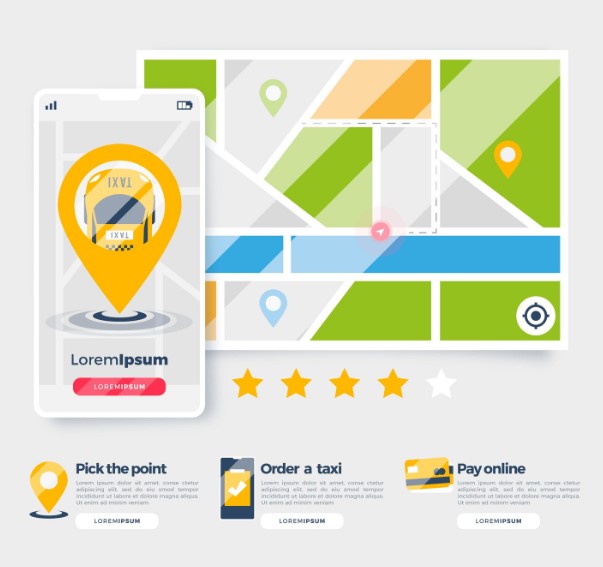Running a taxi company can be a rewarding business — especially when you know your market, use efficient tools like taxi dispatch software, and deliver quality service. But standing out in this industry is far from easy. Competition is fierce: new drivers and small taxi startups appear every month, and large aggregators dominate online search results.
So how can an independent taxi company attract new passengers, build trust, and stay visible in a crowded market? The answer lies in Search Engine Optimization (SEO) — a powerful strategy that helps your company show up when potential customers are looking for a ride.
What SEO means for a taxi company
SEO is more than just a marketing buzzword. It’s a structured approach to improving how your website performs in search engines like Google. When done right, SEO helps your taxi business appear among the top results when people search for local or airport transfers, which directly translates to more bookings and brand visibility.
Think about how most riders find a cab today: they open their phone, type “taxi near me”, “airport transfer Brussels”, or “24/7 cab service”. According to recent data, over 86% of consumers rely on the Internet to find local services. That means your future passengers are already searching for a ride — you just need to make sure they find you, not your competitors.
By investing in SEO, you strengthen your online presence, increase traffic to your website, and position your company as a trusted local provider. Over time, this helps build authority in your region and ensures your brand stays top of mind for regular and new clients alike.
Now that you know what SEO can do for your taxi business, let’s look at the most important part — local visibility. After all, your clients are searching for rides nearby, not on the other side of the country.
Local SEO: The Heart of Every Taxi Business
For taxi companies, success doesn’t depend on being seen everywhere online — it depends on being seen by the right people, in the right place, at the right moment. That’s exactly what Local SEO does.
Local SEO focuses on improving your visibility in location-based searches such as “taxi near me,” “airport transfer Brussels,” or “cab to Charleroi Airport.” These are not random clicks — they’re potential customers who are ready to book a ride now.
Optimize Your Google Business Profile
Your Google Business Profile (GBP) is the cornerstone of local visibility. Make sure it’s complete, accurate, and active. Add:
- clear company name, phone number, and service hours,
- real photos of your cars, drivers, and branded vehicles,
- links to your booking page,
- and detailed descriptions of your routes or airport transfer services.
Encourage satisfied customers to leave reviews. Positive ratings not only build trust but also improve your local search ranking. Respond to every review — even the negative ones — with professionalism. It shows transparency and reliability.
Keep Your NAP Consistent
Search engines verify business legitimacy by cross-checking your NAP (Name, Address, Phone) information across multiple sources — website, social media, and directories. Any inconsistency can lower your ranking or confuse potential customers.
Tip: update your business details anytime you change your phone number, move offices, or adjust service areas.
Add Local Relevance Everywhere
Include the city or region name naturally in your website content — in headlines, service descriptions, and image alt texts. Use photos that reflect your operating area (landmarks, airports, recognizable locations). These small touches help search engines associate your brand with that specific geography.
Build Local Citations and Links
List your taxi service in reputable local directories and travel platforms, such as TripAdvisor, Yelp, or airport transportation listings. These listings act as trusted signals that confirm your business is active in the community.
The stronger your local footprint, the more often Google will show your business to nearby users searching for a ride.

Leveraging SEO for Your Taxi Business
Building a strong SEO strategy for your taxi company isn’t about ticking off technical boxes — it’s about understanding how people search for rides and positioning your brand right where they’re looking. Let’s explore the key steps that make your taxi business visible and trusted online.
Research the Right Keywords for a Taxi Company
Every effective SEO campaign starts with keywords — the exact phrases people type when they’re searching for taxi or ride-hailing services. Without the right ones, even the best-designed website can remain invisible.
Think about what your potential passengers are likely to search for:
“airport taxi Brussels,” “cheap taxi near me,” “book airport transfer Charleroi,” or “24/7 cab service.”
These search terms reveal intent — someone typing them is ready to book. That’s why user-focused keyword research is crucial: it connects your company directly with local customers.
Use reliable tools such as Google Keyword Planner, Ahrefs, or Ubersuggest to discover which phrases have the highest search volume in your area. Don’t stop at obvious words like “taxi” — look for location-based and service-based combinations, such as “corporate taxi service in Brussels” or “taxi from airport to city center.”
Once you’ve defined your list, naturally integrate those keywords into your:
- page titles and meta descriptions,
- service pages,
- blog posts,
- image alt tags,
- and even FAQs.
Remember: keyword optimization isn’t about stuffing words — it’s about understanding how your customers speak and reflecting that language on your website.
Publish Quality Content to Boost SEO for Ride-Hailing
If keywords tell search engines what you do, content shows why you’re worth choosing. In today’s digital world, people expect to find more than just prices — they look for reassurance, useful information, and trust.
A taxi business can grow its visibility by consistently publishing content that helps potential passengers make informed decisions. Some examples include:
- Blog posts — tips for travelers, comparisons of airport routes, local event coverage.
- Videos — explain your booking process or showcase driver professionalism.
- Guides and e-books — “How to Book an Airport Transfer in Under 2 Minutes.”
- Audio or podcast snippets — short insights about safety or travel comfort.
High-quality content isn’t about volume — it’s about value. Your website should provide answers people genuinely need. Google rewards this approach: the more relevant and helpful your content, the higher your site ranks.
To ensure your content performs well:
- Keep it relevant to local travelers and frequent routes.
- Make it easy to read — short sentences, clear structure.
- Write in-depth pieces that actually solve a problem.
- Proofread carefully — clean language builds credibility.
Investing time in content creation pays off. Quality writing builds trust, improves your site’s authority, and keeps your brand top of mind when someone needs a ride.
Content brings people to your site, but technical SEO keeps them there. A slow, poorly optimized website can ruin even the best marketing strategy.
Technical SEO & Mobile Optimization
A strong SEO strategy isn’t just about good content and keywords — it’s also about how your website performs behind the scenes. For a taxi company, where most customers search and book rides on their phones, technical SEO and mobile optimization are absolutely critical.
Speed and Mobile Experience
When someone needs a ride, they won’t wait for a slow website to load. Even a few extra seconds can cost you a potential booking.
Make sure your website:
- loads in under 3 seconds,
- adapts perfectly to any screen size,
- has large, easy-to-tap buttons (like “Book Now” or “Call a Taxi”),
- and displays your contact details without requiring zooming or scrolling.
Use Google PageSpeed Insights or GTmetrix to test your site’s performance and fix any issues that could slow users down. Fast, mobile-friendly pages not only improve the user experience — they also rank higher in Google results.
Security and Accessibility
Trust is everything in the transportation business. That’s why your website must use HTTPS encryption — it reassures both users and search engines that their information is safe.
Also, make your site accessible to all visitors by using clear navigation, readable fonts, and descriptive alt text for images. Accessibility improves usability, which search engines reward with better rankings.
Structured Data and Local Schema
Help search engines understand your business details by implementing structured data (also known as schema markup).
For taxi companies, this means using the LocalBusiness or TaxiService schema type.
It allows Google to display rich results — such as your location, phone number, reviews, and business hours — directly in search snippets.
That extra visibility can double your click-through rate and help passengers find your contact info instantly.
Test Everything Regularly
Technology changes fast — so should your website. Test your booking forms, phone links, and location maps regularly on both Android and iOS devices.
Broken links, outdated plugins, or heavy scripts can silently kill your conversions and SEO ranking.
Remember: your website is not just a brochure — it’s a digital dispatch center. Keep it fast, secure, and mobile-first, and you’ll stay ahead of competitors who overlook these technical essentials.
A mix of SEO precision and real-world service quality is what turns casual visitors into loyal passengers. Keep your strategy agile, data-driven, and focused on the traveler’s experience — that’s the foundation of sustainable growth.
Build a Strong Social Media Presence to Strengthen Your SEO
Ignoring social media today means missing out on thousands of potential passengers. With over 4.8 billion active users across platforms like Facebook, Instagram, TikTok, and LinkedIn, social media has become a crucial discovery channel — especially for local services such as taxi and airport transfers.
When travelers need a quick ride, many don’t go straight to Google — they check social media pages first. They look for photos of vehicles, recent posts, customer reviews, and quick contact options. A taxi company without an active profile often feels outdated or unreliable.
In short, your social media presence is part of your brand credibility. It tells people that your business is real, active, and easy to reach.
How Social Media Impacts SEO
Until a few years ago, search engines didn’t consider social signals in ranking algorithms. But that has changed. Today, social engagement indirectly boosts SEO by:
- increasing brand mentions and backlinks from shared content,
- driving more traffic to your website,
- and improving online visibility through customer interaction.
When your posts are shared or liked, your brand gains visibility beyond your immediate audience — which helps Google see you as a relevant, trustworthy business in your niche.
Choose the Right Platforms for Your Taxi Business
Not every platform fits every audience. The goal isn’t to be everywhere — it’s to be where your clients actually are.
- Facebook & Instagram — ideal for local promotions, photos of vehicles, or customer feedback.
- LinkedIn — great for attracting business clients who book corporate transfers.
- TikTok & YouTube Shorts — short behind-the-scenes clips, driver stories, or travel moments from airports.
- Google Business Profile — technically not a social network, but it’s essential for local SEO and maps visibility.
Before investing time, analyze where your passengers spend their digital time. Track engagement and adjust your strategy accordingly — consistency and authenticity matter more than volume.
Read also: Why Social Media Marketing Matters (Even for Small Taxi Businesses)

Collaborate with Influencers to Boost Visibility
Influencer marketing can be a powerful tool in your SEO and brand growth strategy. In a world where people trust recommendations more than ads, the voice of a respected content creator can instantly build credibility for your taxi company.
Influencers — whether travel bloggers, local lifestyle creators, or business vloggers — already have an established audience that listens to their advice. Partnering with them helps your taxi brand reach new customers who might never have discovered you otherwise.
Imagine a travel influencer showing how they booked your taxi from Brussels Airport to the city center, sharing a positive experience and tagging your company — that’s not just exposure, it’s social proof.
How to Choose the Right Influencers
Not every influencer will be the right fit for your business. The key is relevance and trust, not just follower count.
When selecting influencers:
- Focus on local voices — creators who post about your region or local travel tips.
- Look for genuine engagement — comments, shares, and real discussions.
- Check that their audience matches your target market (tourists, airport travelers, business clients).
- Discuss clear goals: do you want more followers, website traffic, or online bookings?
You can find these creators on platforms like Instagram, TikTok, and YouTube. Even micro-influencers with a smaller but loyal audience can deliver impressive results — especially for localized taxi businesses.
Build High-Quality Backlinks to Strengthen Authority
If influencers help expand your reach, backlinks build your credibility. A backlink is simply a link from another website to yours — but in the SEO world, it acts like a vote of confidence. The more reputable sites reference your taxi business, the more search engines see you as trustworthy and relevant.
Quality backlinks can:
- increase your ranking in Google search results,
- drive referral traffic from partner websites,
- and position your company as an authoritative local service.
To start building them:
- Collaborate with local hotels, airports, and travel blogs — offer mutual linking or guest posts.
- Submit your company to trusted online directories for taxi and airport transfer services.
- Publish valuable resources (e.g., “Top 10 airport routes in Belgium”) that others naturally want to share.
- Reach out to local media with stories about your business growth or sustainability efforts.
Avoid buying links or using spammy link farms — search engines penalize these practices. Focus instead on natural, relationship-based backlinks from respected publishers. Over time, this approach strengthens your SEO foundation and brings a steady flow of relevant visitors.
Once your SEO strategy is in motion, it’s time to measure what’s working and what’s not. Data will help you refine your approach and focus on what drives bookings.
Track and Measure Your SEO Success
Launching an SEO strategy is only half the job — the real growth comes from tracking what actually works. In the taxi business, data-driven decisions make the difference between steady progress and wasted effort.
Set Clear Goals
Before you measure, decide what success means for you. Do you want:
- more online bookings?
- higher website traffic?
- better visibility in Google Maps?
- or more calls coming directly from your site?
Clear goals will help you focus on the right metrics and avoid getting lost in numbers that don’t matter.
Use the Right Tools
Rely on trusted analytics platforms to monitor your progress:
- Google Analytics — track how many visitors come to your site, what pages they view, and how long they stay.
- Google Search Console — see which keywords bring the most clicks and where you appear in search results.
- Google Business Profile Insights — measure calls, direction requests, and profile views from local searches.
Combine these insights to understand how people discover and interact with your taxi company online.
Analyze, Adjust, and Improve
SEO is a continuous process, not a one-time setup. Check your performance monthly or quarterly and adjust based on real data.
If a blog post or page starts performing well, update it with new routes or keywords to keep it fresh.
If something isn’t driving results, identify what’s missing — maybe it needs a stronger call-to-action or better location targeting.
Tracking your SEO helps you make smarter decisions, spend your marketing budget efficiently, and stay ahead of competitors who operate blindly.
Read also: How Google Analytics Can Help Your Taxi Business Grow
Pro Tips for Taxi Companies
Even the best SEO strategy works better when paired with practical improvements in how your business operates online. Here are a few proven tactics to make your taxi company stand out even more:
- Integrate instant booking options.
Add a “Book Now” button or WhatsApp contact directly on your homepage and social media profiles. The fewer steps between a visitor and a ride, the higher your conversion rate. - Collect and highlight customer reviews.
Reviews build trust and boost your Google ranking. Encourage satisfied passengers to leave a short note — it strengthens both your SEO and your reputation. - Create FAQ sections for common routes.
Questions like “How much is a taxi from Brussels Airport to Waterloo?” naturally include local search terms and help you appear for voice and conversational queries. - Use visuals to show reliability.
Include real photos of your fleet, drivers, and pickup points. Authentic visuals improve engagement and time on page — both are good SEO signals. - Update your content regularly.
Search trends and travel habits change fast. Refresh your blogs, add new airport routes, and review keywords at least every few months.
A mix of SEO precision and real-world service quality is what turns casual visitors into loyal passengers. Keep your strategy agile, data-driven, and focused on the traveler’s experience — that’s the foundation of sustainable growth.
Read also: How to Get More Bookings: A Step-by-Step Guide with Expert Tips That Actually Work
Takeaway: Make SEO the Engine That Drives Your Taxi Business Forward
In the fast-paced taxi industry, visibility is everything. No matter how reliable your drivers are or how affordable your fares may be — if people can’t find you online, you’re invisible to most of your potential customers.
SEO is the digital fuel that keeps your taxi business moving forward. It helps you appear in local search results, build trust through valuable content, and turn online searches into real bookings.
Start small, but start right:
- Research the keywords your passengers actually use.
- Create content that answers their real questions.
- Stay active on social media and show your brand’s personality.
- Collaborate with influencers and local partners who can vouch for your service.
- Build backlinks naturally — one meaningful connection at a time.
Every optimization step strengthens your reputation and improves how search engines — and customers — see you.
And over time, that visibility becomes your strongest competitive advantage.
If you’re ready to take your taxi business to the next level, Codico can help you build an SEO strategy that drives real growth — from local visibility to lasting customer trust.
 Subscribe
Subscribe




